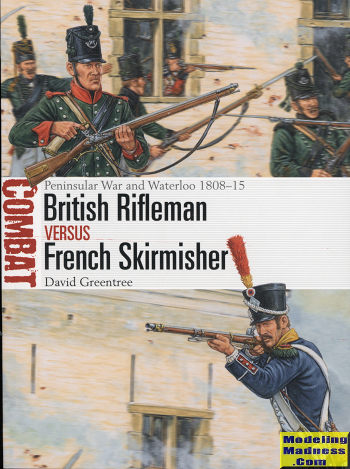 This is
one of Osprey's books in their Combat series. Like the duel series, it pits
contemporaries against each other. Generally there are three battles that show
how the combatants performed and this one is no exception.
This is
one of Osprey's books in their Combat series. Like the duel series, it pits
contemporaries against each other. Generally there are three battles that show
how the combatants performed and this one is no exception. Osprey's British Rifleman vs French Skirmisher
|
Author: |
David Greentree |
|
Publisher/Distributor |
Osprey Publishing |
|
Price |
$20.00 MSRP |
|
Reviewer: |
|
| Notes: |
80 pages, Combat #46 ISBN: 978-1-4728-3184-2 |
 This is
one of Osprey's books in their Combat series. Like the duel series, it pits
contemporaries against each other. Generally there are three battles that show
how the combatants performed and this one is no exception.
This is
one of Osprey's books in their Combat series. Like the duel series, it pits
contemporaries against each other. Generally there are three battles that show
how the combatants performed and this one is no exception.
The subject of this edition is basically riflemen. In the late 1700s, the usual weapon for infantry was the musket. This weapon was grossly inaccurate and by design. It didn't require a lot of training, and thanks to the musket balls being smaller than the inside of the smooth barrel, it tended to bounce around on its way out, making it simple luck if it hit its intended target. Range was about 100 yards. However, the musket was easy to quickly reload and since soldiers stood or advanced line abreast, it proved to be fairly useful.
It was the American Revolution that changed things. In this war, the Colonial Army was made up of men who had used rifles for hunting, something that would be a waste of time with a musket. The rifle required a ball that was almost the same size as the bore of the barrel so that it could use the pressure of the powder explosion more effectively. As a result, it had an accuracy that exceeded that of the musket, reading 300 - 400 yards with ease.
However, the rifle had some drawbacks. One is that it took longer to load. Another is that the soldier actually had to be trained to use it. Finally, the rounds had to be made to closer tolerances. You can also add in that due to the rifling of the barrel, a rifle was more expensive to make and more difficult to clean as you had to ensure that the spent powder was cleaned out of the rifling to prevent backfires.
The use of riflemen was slow to get going for all of the reasons mentioned. They all required different tactics. Due to the accuracy and slow reloading, they couldn't operate in a line as did standard infantry. Instead they used the same tactics as Colonial soldiers by operating in small groups and using available cover to pick off enemy troops (especially officers).
By the time of the Peninsular War, the French had fully embraced the use of riflemen and the British were not all that far behind.
This book discusses the development of rifle armed infantry groups, their training and their leadership. It also covers the changes in tactics required. As mentioned there are three battles covered between the two groups. Two are during the Peninsular War with one showing the effectiveness of riflemen in defense and another as offensive troops. The third is the first battle after the return of Napoleon and points out the problems of the lack of supply of the specialized rifle ammunition that caused defeat for the British side of things.
It is a fascinating look at the changes in infantry warfare of the time and one in which I learned quite a bit. It is a book I liked and I'm sure you will as well.
December 2019
For more on the complete line of Osprey books and to order this one, visit www.ospreypublishing.com .
If you would like your product reviewed fairly and quickly, please contact the editor or see other details in the Note to Contributors.